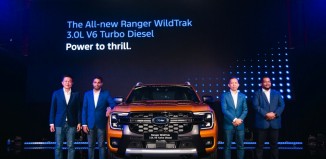Testing The New Honda Civic On Sabah Roads
It might seem a little off the norm for a car company to arrange for a media test drive for a sedan in Sabah, which is better known for its rugged terrain more suited for 4WD vehicles – kudos to Honda Malaysia though for doing the all-new Honda Civic drive in Kota Kinabalu – perhaps Honda senses that there are enough roads now, and want to put more effort to promote ‘normal’ vehicles there.
It was a 3D/2N event and the routing covered many types of terrain, but the one that is most memorable to me would be the one where we did a quick dash from Kota Kinabalu to Kinabalu Park, the push-off point for people who want to climb Malaysia’s highest mountain. This route gave us the opportunity to check out the new Honda Civic over the very challenging hill climb that starts from the roundabout at Tamparuli and ends at the Kinabalu Park itself.
 To bring everyone up to speed on the All-new Honda Civic, we must mention that the Civic comes in a totally new body, and has undergone an ‘engine down-sizing’ exercise. In line with a global trend to cut down emissions through using smaller capacity engines but supplementing the power through the use of a turbo-charger, Honda has followed suit by introducing a 1.5 litre turbocharged engine into the Civic range. This 1.5 litre engine produces 173PS and 220Nm of torque, and this variant replaces the outgoing Civic 2.0 litre which produces 157 PS, and 187Nm of torque. The new Civic has two variants with the 1.5 litre engine, in addition to a 1.8 litre variant that has a carry-over engine from the previous model. The 1.8 litre variant produces 141PS of power and 173Nm of torque, despite being of higher cubic capacity.
To bring everyone up to speed on the All-new Honda Civic, we must mention that the Civic comes in a totally new body, and has undergone an ‘engine down-sizing’ exercise. In line with a global trend to cut down emissions through using smaller capacity engines but supplementing the power through the use of a turbo-charger, Honda has followed suit by introducing a 1.5 litre turbocharged engine into the Civic range. This 1.5 litre engine produces 173PS and 220Nm of torque, and this variant replaces the outgoing Civic 2.0 litre which produces 157 PS, and 187Nm of torque. The new Civic has two variants with the 1.5 litre engine, in addition to a 1.8 litre variant that has a carry-over engine from the previous model. The 1.8 litre variant produces 141PS of power and 173Nm of torque, despite being of higher cubic capacity.
Our car had three media, made up by Uncle Chips Yap, veteran writer from Motor Trader, young Eric Goh of AutoFreaks and yours truly. We started off in the 1.5 litre turbo-charged Civic. Eric, being the youngest, had to give in to seniority, and take the first stint out of Kota Kinabalu city to the outskirts – this part was the boring part, with heavy traffic, made worse by the right lane hoggers. Still, it was a good test of the drivability of the turbo-charged drive train, which drives the front wheels through a CVT (Constantly Variable Transmission).
Not being a real fan of CVT, I still need convincing that it is good – whilst acknowledging the fact that it really contributes to better fuel efficiency, and is smoother in operation, I still do not like the ‘rubber band’ effect that is typical of a CVT, but I cannot argue with the fuel consumption numbers. The good news is, CVT technology is advancing by leaps and bounds, and even as I sit and write this article, there are people working on making the CVT better somewhere in the world. My prejudice against CVT is a result of a poor early experience many years ago, and I must admit that the newer CVT’s are much better.
The climb up the hills to Kinabalu Park is quite steep, with many sharp corners – the road is constantly being improved, and whilst the re-worked parts are generally wider, there are still many parts of the road that are narrow, with many blind corners. Whilst it can be fun driving up at high speed, it can turn ugly, so proper caution is advised, especially around the blind bends, and one must be ready to stop or take evasive action immediately.

It was agreed among the three of us that I take the second stint which starts from the pre-determined Driver change point at Shell Tamparuli and goes up for 40 kilometres to Nabalu Village, while Uncle Chips would take the last stage up to Kinabalu Park for lunch.
As with most turbocharged engines, the Honda Civic excelled on the uphill climb – power delivery was flawless. Whilst most naturally aspirated engines would be under some stress whilst going uphill and also suffer some ‘breathing’ problems due to the increase in altitude, turbocharged engines are not affected as much. The power from the 1.5 turbo is something you would appreciate when you are overtaking – much more so if the overtaking stretches are so much shorter due to the winding nature of the road.
Also much appreciated are the paddle-shifters, mounted in the ideal position just behind the steering wheel, within easy reach, in the conventional minus (-) left hand paddle and the plus (+) right hand paddle. The paddle shifters allow one to hold the gear ratios and keep the engine on the ‘boil’, making the drive more enjoyable. For certain, the paddle shifters make the CVT more fun – it will be somewhat detrimental to your overall fuel efficiency, but I think that driving is not always about fuel efficiency, and one should let one’s hair down every once in a while. So a final word on the CVT – the paddle shifters are the saving grace – with them, I can select the ‘gear’ I want to be in, and maintain some measure of control over the transmission.
The Honda Civic is primarily a family sedan – it is well sprung, and the suspension set-up is what I would call ‘the firm side of comfortable’, which means that it is comfortable enough, yet can be ‘pushed’ a little for those who like fast driving. As far as I am concerned, the Civic took on the hills and conquered them without any problem at all. It ‘sits’ down firmly when you transfer the weight to the front just prior to entering any corner, and then it holds its attitude throughout.
I suppose Uncle Chips might have shared my thoughts on how great the Civic was – on the third stint from Nabalu to Kinabalu Park, the road was even more winding and the corners were even sharper, but he seemed to enjoy pushing the Civic to the limit, to the point of screeching tyres and huge amounts of sideways G-forces. The Civic took all of that in its stride, without any protest at all.
The new Civic continues to use an electrical power steering system – no issues here – if I didn’t tell you that the steering is electrically powered, you probably wouldn’t even know it. Steering response is precise, with just the right amount of feedback to the hands, and I felt very reassured at all times. Straight line stability, lane change stability and cornering stability get full marks from me – the Civic is very easy to drive.
For the return trip, we opted for the one and only 1.8 litre Civic available – I figured that it would be great to drive the 1.8 Civic as a comparison against the 1.5 litre turbo. Of course, going downhill, we didn’t need as much power, and neither did the 1.5 turbo Civics, and needless to say, the 1.8 Civic performed just as well. Other than the difference in the engine performance, the 1.8 litre Civic did just as well as the 1.5 turbo did.
Because everybody else was tired, I got to drive all the way to the city of Kota Kinabalu. Down in the lowland area, I got a chance to check out just how adequate the 1.8 litre engine was with its new CVT. Moving back into what I said earlier, the CVT makes for better fuel efficiency, and after driving it for close to an hour, it is my conclusion that the Honda Civic 1.8 is more than adequate for approximately 80 percent of the people who are likely to want to buy it. Of course there will always be those who want to top specs all the time and still go for the 1.5 turbo, which is perfectly all right too.
All things said and done, the question remains as to which one should one buy – my answer would be – both are good. Your final choice of variant, whether it is the 1.5 Turbo or the naturally-aspirated 1.8 litre Civic, would be dependent on whether you believe you need the additional power or not.







































